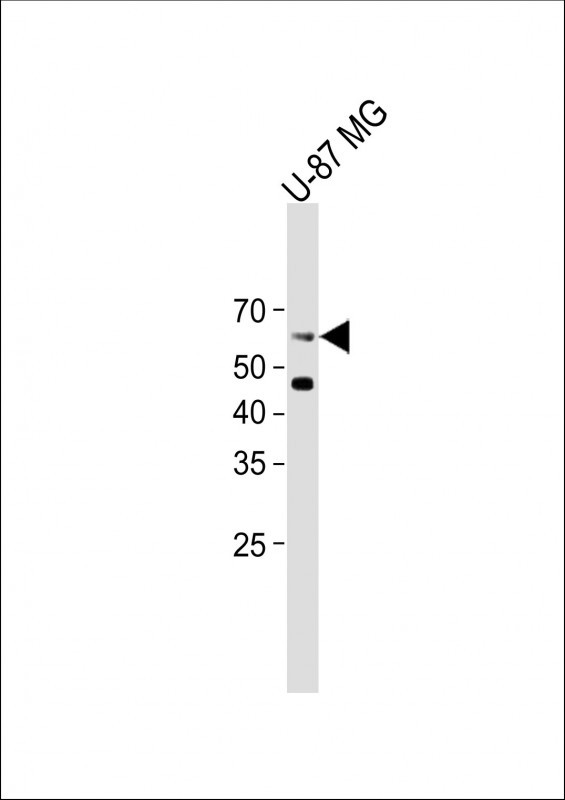CPEB1 Antibody (C-term)
Affinity Purified Rabbit Polyclonal Antibody (Pab)
- 产品详情
- 实验流程
- 背景知识
Application
| WB, E |
|---|---|
| Primary Accession | Q9BZB8 |
| Other Accession | P0C279, P70166, Q9YGX5, Q52KN7, Q91572, NP_001073001.1, NP_001073002.1 |
| Reactivity | Human |
| Predicted | Xenopus, Zebrafish, Mouse, Rat |
| Host | Rabbit |
| Clonality | Polyclonal |
| Isotype | Rabbit IgG |
| Calculated MW | 62595 Da |
| Antigen Region | 447-475 aa |
| Gene ID | 64506 |
|---|---|
| Other Names | Cytoplasmic polyadenylation element-binding protein 1, CPE-BP1, CPE-binding protein 1, h-CEBP, hCPEB-1, CPEB1, CPEB |
| Target/Specificity | This CPEB1 antibody is generated from rabbits immunized with a KLH conjugated synthetic peptide between 447-475 amino acids from the C-terminal region of human CPEB1. |
| Dilution | WB~~1:1000 E~~Use at an assay dependent concentration. |
| Format | Purified polyclonal antibody supplied in PBS with 0.05% (V/V) Proclin 300. This antibody is purified through a protein A column, followed by peptide affinity purification. |
| Storage | Maintain refrigerated at 2-8°C for up to 2 weeks. For long term storage store at -20°C in small aliquots to prevent freeze-thaw cycles. |
| Precautions | CPEB1 Antibody (C-term) is for research use only and not for use in diagnostic or therapeutic procedures. |
| Name | CPEB1 |
|---|---|
| Synonyms | CPEB |
| Function | Sequence-specific RNA-binding protein that regulates mRNA cytoplasmic polyadenylation and translation initiation during oocyte maturation, early development and at postsynapse sites of neurons. Binds to the cytoplasmic polyadenylation element (CPE), an uridine-rich sequence element (consensus sequence 5'-UUUUUAU-3') within the mRNA 3'- UTR. RNA binding results in a clear conformational change analogous to the Venus fly trap mechanism (PubMed:24990967). In absence of phosphorylation and in association with TACC3 is also involved as a repressor of translation of CPE-containing mRNA; a repression that is relieved by phosphorylation or degradation (By similarity). Involved in the transport of CPE-containing mRNA to dendrites; those mRNAs may be transported to dendrites in a translationally dormant form and translationally activated at synapses (By similarity). Its interaction with APLP1 promotes local CPE-containing mRNA polyadenylation and translation activation (By similarity). Induces the assembly of stress granules in the absence of stress. Required for cell cycle progression, specifically for prophase entry (PubMed:26398195). |
| Cellular Location | Cytoplasm. Nucleus Cytoplasm, P-body. Cytoplasmic granule. Synapse. Membrane. Postsynaptic density. Cell projection, dendrite Note=Continuously shuttling between nucleus and cytoplasm (PubMed:18923137). Also found in stress granules. Recruited to stress granules (SGs) upon arsenite treatment. In dendrites (By similarity) Localizes in synaptosomes at dendritic synapses of neurons (By similarity). Strongly enriched in postsynaptic density (PSD) fractions (By similarity). Transported into dendrites in a microtubule-dependent fashion and colocalizes in mRNA-containing particles with TACC3, dynein and kinesin (By similarity). Membrane-associated (By similarity) Colocalizes at excitatory synapses with members of the polyadenylation and translation complex factors (CPSF, APLP1, TACC3, AURKA, SYP, etc.) including CPE-containing RNAs (By similarity). {ECO:0000250, ECO:0000269|PubMed:18923137} |
| Tissue Location | Isoform 1 is expressed in immature oocytes, ovary, brain and heart. Isoform 2 is expressed in brain and heart. Isoform 3 and isoform 4 are expressed in brain. Expressed in breast tumors and several tumor cell lines. |
For Research Use Only. Not For Use In Diagnostic Procedures.
Provided below are standard protocols that you may find useful for product applications.
BACKGROUND
This gene encodes a member of the cytoplasmic polyadenylation element (CPE) binding protein family. This highly conserved protein binds to a specific RNA sequence called the CPE found in the 3' UTR of some mRNAs. Similar proteins in Xenopus and mouse function to induce cytoplasmic polyadenylation of dormant mRNAs with short polyA tails, resulting in their translation. Members of this protein family regulate translation of cyclin B1 during embryonic cell divisions. Multiple transcript variants encoding different isoforms have been found for this gene.
REFERENCES
Glahder, J.A., et al. Virus Res. 149(2):217-223(2010)
Crowther-Swanepoel, D., et al. Nat. Genet. 42(2):132-136(2010)
Hansen, C.N., et al. APMIS 117(1):53-59(2009)
Ernoult-Lange, M., et al. Mol. Biol. Cell 20(1):176-187(2009)
Burns, D.M., et al. Genes Dev. 22(24):3449-3460(2008)
终于等到您。ABCEPTA(百远生物)抗体产品。
点击下方“我要评价 ”按钮提交您的反馈信息,您的反馈和评价是我们最宝贵的财富之一,
我们将在1-3个工作日内处理您的反馈信息。
如有疑问,联系:0512-88856768 tech-china@abcepta.com.























 癌症的基本特征包括细胞增殖、血管生成、迁移、凋亡逃避机制和细胞永生等。找到癌症发生过程中这些通路的关键标记物和对应的抗体用于检测至关重要。
癌症的基本特征包括细胞增殖、血管生成、迁移、凋亡逃避机制和细胞永生等。找到癌症发生过程中这些通路的关键标记物和对应的抗体用于检测至关重要。 为您推荐一个泛素化位点预测神器——泛素化分析工具,可以为您的蛋白的泛素化位点作出预测和评分。
为您推荐一个泛素化位点预测神器——泛素化分析工具,可以为您的蛋白的泛素化位点作出预测和评分。 细胞自噬受体图形绘图工具为你的蛋白的细胞受体结合位点作出预测和评分,识别结合到自噬通路中的蛋白是非常重要的,便于让我们理解自噬在正常生理、病理过程中的作用,如发育、细胞分化、神经退化性疾病、压力条件下、感染和癌症。
细胞自噬受体图形绘图工具为你的蛋白的细胞受体结合位点作出预测和评分,识别结合到自噬通路中的蛋白是非常重要的,便于让我们理解自噬在正常生理、病理过程中的作用,如发育、细胞分化、神经退化性疾病、压力条件下、感染和癌症。






